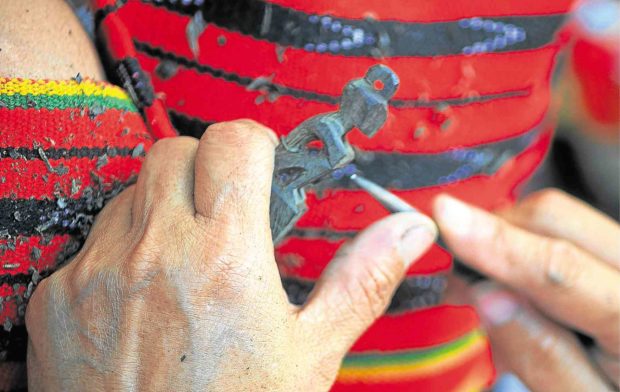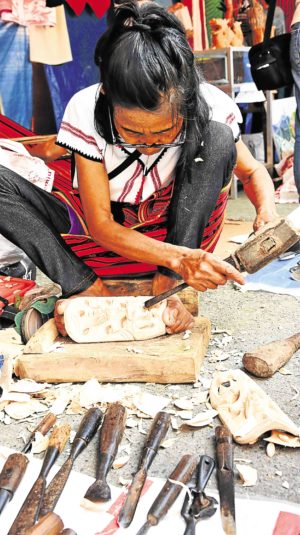Ifugao women now expert woodcarvers

WOMAN’S TOUCH Female woodcarvers in Ifugao province are patient and meticulous, often working on small pieces sold to tourists. —EV ESPIRITU
BANAUE, Ifugao — Lourdes Gayumma has become an expert artisan, after joining a group of women building a reputation in the traditionally male-dominated woodcarving industry in a town renowned for its majestic rice terraces.
Eighteen women carvers from Barangay Viewpoint and Bocos here formed the Banaue Women Sculptors Organization in 2016, and took center stage in this year’s Imbayah Festival when they engaged their male counterparts in a friendly carving competition.
Ifugao “mumpaot” (carvers) are mostly men, said municipal assessor, Peter Udan, who supervised the event. Women are often tasked with weaving baskets and traditional dresses or with helping polish woodcraft into smooth texture finish, he said.
Meticulous hands
The female mumpaot carve inch-tall miniature replicas of Ifugao icons like “bulol” (rice granary guardians), “lingling-o” (charms) and native huts, which are dangled as necklaces or key chains. They also carve nontraditional shapes like footlong dragons and masks.

Elizabeth Dulnuan is among the growing number of female “mumpaot” (woodcarvers) in Banaue. —EV ESPIRITU
Udan said male mumpaot prefer to make larger pieces because working on very small ones requires patience and meticulous hands. So when the women sell necklaces or key chains at P35 apiece, the price tag is actually far below their real value, he said.
The local government, according to Udan, is working with the organization to appraise the marketable value of the women’s “very detailed work.”
Although bigger wood pieces command higher prices, they do not sell as fast as the key chains and necklaces, said Elizabeth Dulnuan, 47, of Barangay Viewpoint.
Like Dulnuan, some women learned how to carve at a young age. They abandoned their chisels when they married and began building their own families, only to pick up the craft again. Other female mumpaot like Gayumma were taught by their husbands.
Additional income
All pursued the craft as means of augmenting the income of the household. “Without our carvings, we might not be able to send our children to school,” said Gayumma, who has five children, one already in college.
Planting heirloom rice called “tinawon,” which means “once a year,” is the main industry in Banaue aside from tourism. But the annual harvest is no longer a sufficient source of livelihood, Udan said.














